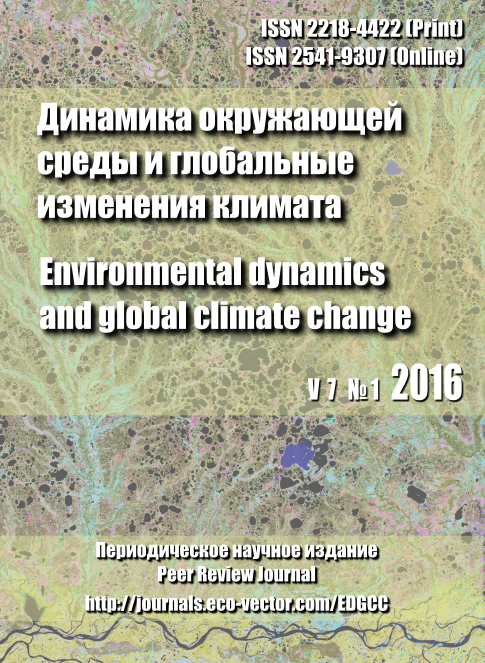The soil phytoliths analysis of meadow and steppe phytocenoses in Altai region
- Authors: Speranskaya NY.1, Solomonova MY.1, Geynrich Y.V1
-
Affiliations:
- ФГБОУ ВПО «Алтайский государственный университет»
- Issue: Vol 7, No 1 (2016)
- Pages: 148-154
- Section: Articles
- Published: 15.06.2016
- URL: https://edgccjournal.org/EDGCC/article/view/6347
- DOI: https://doi.org/10.17816/edgcc71148-154
- ID: 6347
Cite item
Full Text
Abstract
This article describes the phytoliths spectra of meadow and steppe phytocenoses from Altai region. The soil was taken from the three meadow plant communities and two steppe plant communities. Meadow plant communities were included upland meadows and abandoned field. Steppe plant communities were presented various options of fescue steppes. Soil samples were processed using the maceration method. Forms phytolites were counted using a light microscope. Quantity phytoliths from various samples was estimated to 200 pieces. We called phytolites according to international code of nomenclature phytoliths. The species composition of dominant plant was described for every plant formation. Plant species: Bromopsis inermis, Elytrigia repens and genera Festuca are found in most phytocenoses. The phytoliths of different plant taxa are of diverse specificity. 17 forms of phytoliths were allocated. Morphological types of phytoliths in various spectra from 13 and till 17 forms. Different morphotypes of grass phytoliths are important diagnostic factors in soil analysis due to their ecological-phytocenotic specificity. Trapeziform short cells, trapeziform sinuates, bilobate short cells, trapeziform polylobates, trichomes, rondels are found in all phytocenosises. Grasses are produced these phytolites. Phytoliths spectra from soils of the Altai region were compared with the composition of phytoliths in soil of the European part of Russia which were published Gol'eva AA. We identified correspondence with between phytolith spectra of upland meadows from the Altai region and phytolith spectra of dry meadows from the European part of Russia. Phytoliths spectra upland meadow communities had many phytoliths in the form: rondel, trichomes and long cells. Trapeziform polylobates are often founding. Phytoliths spectra steppe communities had many phytoliths in the form: trapeziform short cells, rondel. Trapeziform polylobates, trichomes found less often. Perforated rods are more likely to occur long cells as in the steppe and the meadow plant communities. The basic result is correlation between phytocenoses and phytoliths spectra. The difference phytoliths spectra of meadows and steppes was found. The morphotypes of grass phytoliths of the south of Western Siberia are marked by specific eco-coenotic features. The research may be useful for scientists in the field: archeology, ecology and paleoecology, paleobotany, pedology and paleo soil science, paleoclimatology. The article has supporting data, for example, plant phytoliths photos, graphics of phytoliths spectra.
Keywords
About the authors
N Yu Speranskaya
ФГБОУ ВПО «Алтайский государственный университет»
Author for correspondence.
Email: speranskaj@mail.ru
г. Барнаул
M Yu Solomonova
ФГБОУ ВПО «Алтайский государственный университет»
Email: speranskaj@mail.ru
г. Барнаул
Yu V Geynrich
ФГБОУ ВПО «Алтайский государственный университет»
Email: speranskaj@mail.ru
г. Барнаул
References
- Гальцова Т.В., Сперанская Н.Ю. 2013. Разнообразие фитолитов Panicum miliaceum L. и P. ruderale (Kitag.) Chang., произрастающих на территории Алтайского края // Проблемы ботаники Южной Сибири и Монголии. С. 67-69.
- Гольева А.А. 2001. Фитолиты и их информационная роль в изучении природных и архелогических объектов. Сывктывкар. 200 с.
- Динесман Л.Г., Киселева Н.К., Князев А.В. 1989. История степных экосистем Монгольской Народной Республики. М: Наука. 215 с.
- Куминова А.В., Вагина Т.А., Лапшина Е.А. 1963. Геоботаническое районирование юго-востока Западно-Сибирской низменности // Растительность степной и лесостепной зон Западной Сибири. Новосибирск: Изд-во СО АН СССР. С. 35-62.
- Куминова А.В., Митрофанова М.П. 1963. Суходольные луга Приобья // Растительность степной и лесостепной зон Западной Сибири. Новосибирск: Изд-во СО АН СССР. С. 285-305.
- Соломонова М.Ю., Сперанская Н.Ю., Силантьева М.М., Митус А.А. 2015. Встречаемость фитолитов в форме трапециевидных коротких частиц у злаков различных эколого-ценотических групп юга Западной Сибири // Проблемы ботаники Южной Сибири и Монголии. С. 295-300.
- Сперанская Н.Ю., Соломонова М.Ю., Силантьева М.М. 2014. Разнообразие фитолитов ковылей (Stipa) юга Западной Сибири // Известия АлтГУ. Т. 1. № 3 (83). С. 89-94.
- Сперанская Н.Ю., Соломонова М.Ю., Силантьева М.М. 2013.Трихомы и лопастные фитолиты растений как возможные индикаторы мезофильных сообществ при реконструкции растительности // Приволжский научный вестник. № 11 (27). С. 40-46.
- Carnelli A.L., Theurillat J.-P., Madella M. 2004. Phytolith types and type-frequencies in subalpine-alpine plant species of the European Alps // Review of Palaeobotany and Palynology. V. 129. P. 39-65.
- Fernandez H.M., Zucol A.F., Osterrieth M.L. 2006. Phytolith Assemblages and Systematic Associations in Grassland Species of the South-Eastern Pampean Plains, Argentina // Annals of Botany. V. 98. P. 1155-1165.
Supplementary files










